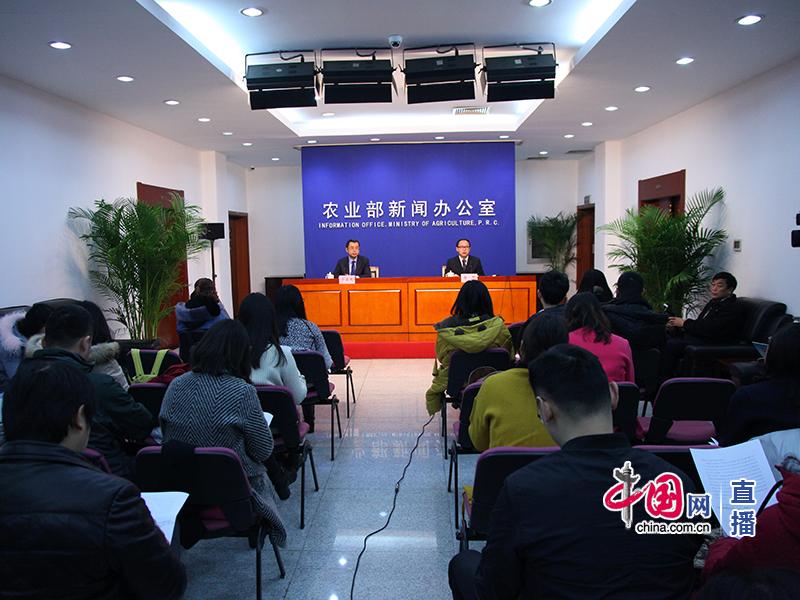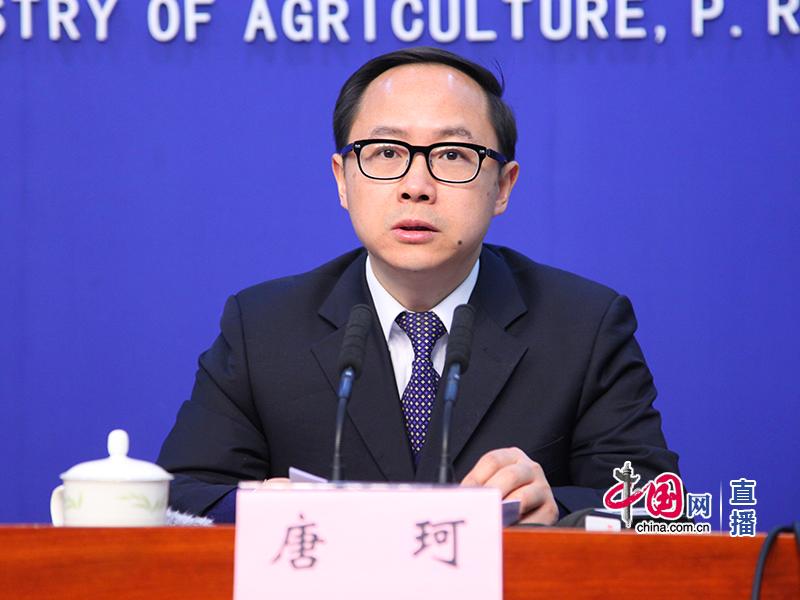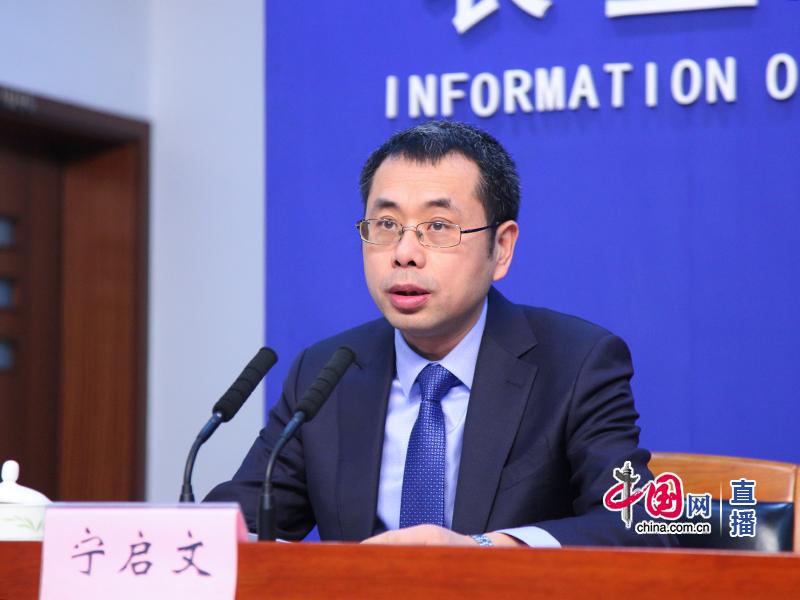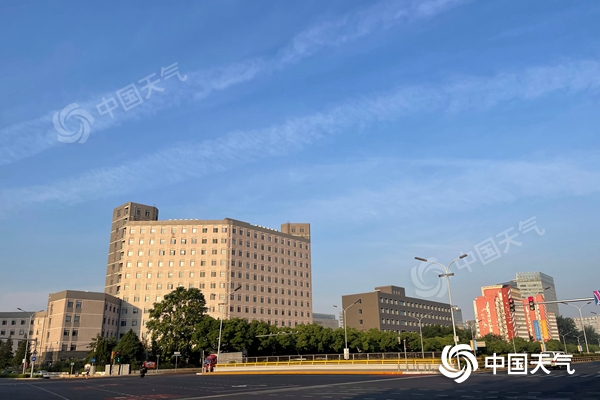
At the press conference. China Net Guo Tianhu photo
At 10: 00 am on Wednesday, January 17, 2018, the Information Office of the Ministry of Agriculture held a press conference on key agricultural products markets to inform the operation of major agricultural products markets in 2017, interpret the current hot issues in the agricultural products market, and answer questions from reporters.
[Ning Qiwen, Deputy Director of the General Office of the Ministry of Agriculture]Good morning, ladies and gentlemen, friends from the media! Welcome to the press conference held by the Information Office of the Ministry of Agriculture. In 2017, the Information Office of the Ministry of Agriculture held 19 press conferences, and the work of the press conferences was strongly supported by all media friends. I would like to express my heartfelt thanks to everyone for their hard work and positive attention to the work of our department. In the new year, I hope you will continue to support our press release work, and we will continue to strive to provide you with more and better services. Today, the first regular press conference in 2018 was held, with the theme of the operation of key agricultural products markets in 2017. First of all, I would like to invite Comrade Keke, Director of the Market and Economic Information Department of the Ministry of Agriculture, to inform you about the situation.

Keke, Director of the Department of Market and Economic Information of the Ministry of Agriculture, introduced the situation. China Net Guo Tianhu photo
[Keke, Director of Market and Economic Information Department of the Ministry of Agriculture]Good morning, ladies and gentlemen, friends from the media. First of all, thank you for attending today’s regular press conference. The Central Rural Work Conference and the National Agricultural Work Conference held not long ago made comprehensive arrangements for implementing the rural revitalization strategy. In 2018, the Ministry will continue to release market information of key agricultural products every quarter, and guide agriculture to change from increasing production to improving quality through information services. Next, I will inform you about the operation of the key agricultural products market in 2017.
In 2017, new progress was made in the structural reform of the agricultural supply side, and substantial results were achieved in the reform of the grain price formation mechanism and the purchasing and storage system of important agricultural products. China’s agricultural products market was generally stable. According to the National Bureau of Statistics, the food price dropped by 1.4% in 2017, which was the first decline since 2003. According to the monitoring of our Ministry, the annual average of the "Agricultural Products Wholesale Price 200 Index" was 100.14 (100 in 2015), 5.60 points lower than the same period of last year; Among them, the "vegetable basket" product 200 index was 99.91, 6.65 points lower than the same period of last year. The operation of agricultural products market in the whole year presents three characteristics:
First, the prices of bulk agricultural products are mainly stable, and the characteristics of "market pricing" are more obvious. In 2017, the minimum purchase price of rice was slightly lowered, the minimum purchase price of wheat remained stable, the reform of corn storage and storage system continued to deepen, bulk agricultural products were still in the period of inventory digestion, and food prices generally declined steadily. According to monitoring, the average price of rice, wheat and corn in 2017 was 122.10 yuan per 100 kg, down 0.3% year-on-year. With the further development of market mechanism, the price trend of different varieties has been differentiated. The multi-subject acquisition of early indica rice was active, and the market-oriented acquisition accounted for 86.4%, an increase of 16 percentage points over the previous year; The quality of wheat is obviously better than that of last year. After the listing of new wheat, the market is active and the price continues to rise. Corn continued to be reduced, and the purchase price of new grain increased steadily after listing, and the price in Northeast China increased greatly. The annual average price of cotton, rape, sugar and other varieties increased by more than 10% year-on-year, while soybean, peanut and other varieties with more yield increased declined to varying degrees.
Second, the price of fresh agricultural products first fell and then rose, and the overall stability was slightly lower. In 2017, the market operation of "vegetable basket" products basically conforms to the law of cyclical seasonal fluctuation, and the price level is generally lower than that of the previous year. In terms of varieties, due to the rapid recovery of the weather in the north at the beginning of the year, a large number of vegetables were listed intensively after the spring, and the prices fell early and sharply. After summer and autumn, the prices rebounded rapidly. The average wholesale price of 28 kinds of vegetables was 3.73 yuan per kilogram, down 10.6% year-on-year. The production and demand of livestock and poultry products were unbalanced, and the prices of pork, poultry meat and eggs dropped sharply in the first half of the year, but rose again in the second half. The average price of pork wholesale market in the whole year was 21.24 yuan per kilogram, down 14.6% year-on-year. White striped chicken is 13.93 yuan per kilogram, down 6.5% year-on-year; Poultry eggs were 6.92 yuan per kilogram, down 7.6% year-on-year. Affected by tight supply, the price of beef and mutton, especially mutton, continued to rise, and the increase expanded after August. The average price of beef and mutton wholesale market in the whole year was 53.82 yuan and 47.49 yuan per kilogram, up 1.1% and 5.4% respectively. The prices of fruits and aquatic products have increased.
Third, the impact of the international market on the domestic market has further increased, and the import of agricultural products has continued to grow rapidly. In 2017, the trade volume, import volume and export volume of China’s agricultural products all reached record highs, and the linkage between international and domestic markets was further strengthened. Driven by demand and import price advantages, the growth rate of agricultural products imports was significantly greater than that of exports, and the trade deficit continued to expand. From January to November, the trade volume of China’s agricultural products was US$ 181.85 billion, up 9.8% year-on-year, of which the export value was US$ 67.70 billion, up 3.1%. Imports reached US$ 114.15 billion, up by 14.2%; The trade deficit was US$ 46.45 billion, up by 35.3%. Soybean is still the largest variety of agricultural products imported, with the import volume reaching 85.99 million tons, up 15.8% year-on-year; Driven by the upgrading of domestic consumption, the import of special aquatic products such as cod, cuttlefish and squid increased rapidly, while the import of special fruits such as cherries, grapes, citrus, durian and bananas remained high.
At present, the supply of "vegetable basket" products is generally plentiful. Although the large-scale rain and snow in the central and eastern regions at the beginning of the new year and the subsequent cold wave weather have had a certain impact on the production and circulation of vegetables, due to the increase in the field area and the abundant storage of vegetables in winter, the supply of fresh agricultural products, including vegetables, is guaranteed during the Spring Festival, and it is unlikely that the overall price will rise sharply.
Looking forward to the situation in 2018, under the background that the global supply and demand of agricultural products continue to be generally loose and the structural reform of China’s agricultural supply side is further promoted, the operation of domestic agricultural products market is expected to remain generally stable. However, with the deepening of the linkage between international and domestic markets and the superposition of external uncertainties such as changes in international exchange rates and adjustment of trade policies, the situation of China’s agricultural products market will become more complicated. According to the analysis of the market early warning expert Committee of the Ministry of Agriculture, it is expected that with the reduction of the minimum purchase price of grain, the characteristics of high quality and good price of rice and wheat and booming market will become more obvious this year; The digestion of corn stocks may be further accelerated, and the price will fluctuate slightly under the adjustment of market supply and demand; Imports of oilseeds, cotton and sugar may increase, and the downward pressure on some varieties will increase; Fresh agricultural products are expected to be generally stable, and the prices of livestock products such as beef and mutton are expected to rise steadily.
In order to solve the problem of "can’t find, can’t understand and can’t use" market information, the market information platform of key agricultural products we specially built was officially put into operation on November 10th last year. At present, the platform can be publicly inquired on the official website data channel of the Ministry of Agriculture. For the first time, the platform strung together the data of the whole industrial chain with varieties as the main line, creating a "catch all the nets" information publishing service platform, opening a large number of machine-readable raw data for the first time, promoting the redevelopment and reuse of data resources, and providing visualization tools based on big data technology for the first time, which is convenient for the public to analyze and make decisions online. In the next step, we will continue to broaden the data sources of the platform, constantly innovate and expand the service content, and strive to make the platform a fast platform, an authoritative platform and an objective platform, so that the platform can truly become a good helper for the production and operation of farmers’ friends, help farmers’ friends to share more development achievements in the process of agricultural modernization, and make great strides on the road to a well-off society in an all-round way. I also hope that media friends will pay more attention and support!
Now I’d like to answer your questions.

Ning Qiwen, deputy director of the General Office of the Ministry of Agriculture, presided over the conference. China Net Guo Tianhu photo
[Ning Qiwen]Thank you, Director Keke. Let’s invite reporters to ask questions, and please inform the media organizations you represent when asking questions.
[CCTV reporter]Hello, Director Tang. Just now, when you introduced the general situation of China, you said that the operation of China’s agricultural products market is expected to remain generally stable in 2018. However, due to the superposition of uncertain factors, the situation of China’s agricultural products market may be more complicated. What problems should be focused on in the next step?
[Keke]There are many factors that affect the operation of agricultural products market, besides the fundamentals of supply and demand, there are also many aspects such as regulation and control policies, import and export trade and macroeconomics, so it is difficult to make a relatively accurate forecast. However, we can sort out the key problems that affect the market operation, make a good judgment in advance, prompt the market risks, and make a good response plan to prevent the ups and downs of production and market. In the previous paragraph, through expert consultation, we think that there are four issues that need to be paid attention to in 2018.
First, the impact of the downward adjustment of the minimum purchase price of rice and wheat. On the premise of adhering to the minimum purchase price policy framework, the state has appropriately adjusted the minimum purchase price level of rice and wheat from the previous year according to changes in production costs and market supply and demand, which not only released the signal of the reform of the grain storage system, but also left room for the role of the market mechanism. It is expected that the market-oriented purchase and sale of rice and wheat will be further active this year, and the characteristics of high quality and good price will be further obvious. However, the impact of price reduction on production links needs to be comprehensively tracked and analyzed, and the corresponding supporting policies should be improved to ensure that farmers’ income from grain production in the main producing areas is basically stable.
Second, the new changes in the production and marketing situation of corn need to be paid attention to. In 2017, the progress of corn inventory digestion exceeded expectations, and the trend of stable and strong market prices also exceeded expectations. In particular, at the end of November, the purchase and sale of corn in Northeast China was active, with the volume and price rising, and the benefit of corn planting was obviously better than that of the previous year. According to experts’ preliminary scheduling, it is expected that farmers’ enthusiasm for corn planting in Northeast China will increase in 2018, so it is necessary to closely track the changes of farmers’ planting intentions, and coordinate the subsidies for corn and soybean producers and the subsidies for crop rotation and fallow. Continue to guide corn production to concentrate in advantageous areas through policies.
Third, the intensification of international competition needs to be focused on. In recent years, the relationship between global grain supply and demand has remained loose, and the growth of output and inventory has been accompanied by the continuous decline of prices. According to the data of FAO, the world grain output increased from 2.294 billion tons to 2.610 billion tons in 2012-2016, with an average annual growth rate of 3.3%. In the past four years, the average grain production in the world exceeded the demand, and the cumulative inventory at the end of the period increased by 32.2%. The FAO food price index fluctuated from 213 in 2012 to 161 in 2016, with a cumulative decline of 52 points. According to the latest forecast of FAO in December 2017, the global grain supply and demand in 2017/2018 is still in a loose pattern. It is estimated that the import pressure of China’s bulk agricultural products will remain relatively high in 2018, and the import of specialty grain and oil, fruits and vegetables, aquatic products and branded foods will still grow rapidly, and China’s agricultural development will face increasingly fierce international competition. Our department is continuously enhancing the competitiveness of advantageous industries and increasing farmers’ income by promoting quality, strengthening agriculture with brand and giving priority to efficiency.
The fourth is the conduction effect of macro factors. In recent years, with the enhancement of the financial attributes of agricultural products and the promotion of agricultural industrialization, the influence of external factors on agriculture has been deepening. In 2018, the first thing that needs to be focused on is the sharp rise in the price of chemical fertilizers, which pushes up the cost of agricultural production. It is necessary to ensure the supply of spring ploughing media to prevent the rising cost from meeting with the downward trend of food prices and dampen farmers’ enthusiasm for production. Secondly, we need to pay attention to the rising inflation expectations, rationally treat the rising prices of some agricultural products such as beef and mutton as well as seasonal and cyclical fluctuations, and prevent excessive speculation on the normal fluctuations of the agricultural products market.
Finally, we need to pay attention to the more complicated and changeable international situation, especially the influence of external factors such as the continuous interest rate increase by the Federal Reserve, the substantial tax reduction by the United States, and the fluctuation of crude oil prices on the operation of agricultural products market. We will organize experts to carry out in-depth research and comprehensive evaluation on the above problems and put forward countermeasures in time. I also hope that media friends will pay more attention, conduct research and exchanges, publicize good practices and experiences of various departments and localities, and jointly create a good environment for the smooth operation of agricultural products, the sustained and healthy development of agriculture and the structural reform of agricultural supply side. Thank you.
[People’s Daily reporter]Since New Year’s Day, we all feel that the weather situation has changed significantly compared with last year, and the temperature has dropped. First, there have been two large-scale rains and snows in the central and eastern regions, and then a cold wave has ushered in the southern region of the Yellow River. Vegetable production and supply are bound to be affected to some extent, and prices in some areas fluctuate greatly. What is the trend of vegetable prices? Does it affect the vegetable supply during the Spring Festival?
[Keke]Recently, we have continuously strengthened the dispatching of vegetable production and marketing situation, and organized experts to hold a special discussion on the impact of this round of extreme weather. Generally speaking, this period of low temperature rain and snow has affected the vegetable production and marketing in some areas of Jiangnan, South China and Huanghuaihai to a certain extent, and affected the transportation of vegetables from South to North in stages, resulting in the differentiation of vegetable prices in the production and marketing areas of North and South, and the fluctuation of individual varieties is large. According to the monitoring data of the wholesale market of our department, the vegetable prices in Hubei and Anhui, which have a large snowfall in the main producing areas in the south, have increased significantly. The average weekly price after snowfall was 4.07 yuan and 3.97 yuan per kilogram, respectively, up 7.6% and 5.8% from the previous month, while the vegetable prices in Jiangxi, Hunan and other regions were relatively stable. Individual varieties in the northern sales area fluctuate greatly. The yellow cabbage and lettuce from Anhui, cauliflower from Jiangsu, white radish and cabbage from Hubei in the Beijing market have all increased by a large margin, while winter storage vegetables such as Chinese cabbage, onions and potatoes have been harvested last autumn, and the prices are basically stable at present.
From the later trend, it is expected that it will take some time for the production of some disaster-stricken areas to resume in the short term, and the price of vegetables transported across regions will still run at a high level. According to the information of vegetable production monitored by our department, the area of vegetables in 58 key vegetable counties increased steadily from September to November 2017, and the vegetable output in September was 1.13 million tons, up 3.6% year-on-year, and it was flat in October and November. The overall supply situation in the future is optimistic. If there is no longer a large-scale and long-term extreme weather in the later period, it is expected that the production and supply of vegetables will gradually improve, and the supply of vegetables will be guaranteed during the Spring Festival, and the price will rise seasonally. Remind the majority of vegetable farmers to pay close attention to the weather changes, do a good job in disaster prevention and mitigation in time, choose the opportunity to harvest and go public, and achieve loss and income increase.
[china national radio reporter]Excuse me, Director Tang, at present, the price of mutton continues to rise, and there is a voice in the market that the phenomenon of "sheep’s noble concubine" may reappear from 2011 to 2013. What do you think of the rising trend of mutton in that year? What is the difference between this year’s rising trend and previous years’? What is the later trend?
[Keke]In the second half of 2017, the price of mutton in China continued to rise, especially after August, with a cumulative increase of more than 10%, which attracted everyone’s attention. After organizing experts’ analysis, we think that compared with previous years, this mutton price increase has several characteristics: First, it is generally in line with the trend of previous years, but it has increased greatly in the later period. In the fourth week of December, the price of mutton market reached 60.34 yuan per kilogram, with a cumulative increase of 10.9%. Second, the price of live sheep has increased significantly, and the breeding benefits have improved. In the budget estimate for the whole year of 2017, the income of slaughtering a 45kg sheep and a 30kg goat is higher than that of 130 yuan and 25 yuan respectively. Third, the average annual price is basically the same as that of the previous year, and it is still at a low level in the past five years. The current increase in mutton prices is a normal response to the slight decline in production caused by the low efficiency of raising sheep in 2016. It is a recovery increase under the adjustment of supply and demand, and it is the result of the joint influence of the booming market demand and the tight supply stage, which needs to be treated rationally.
From the specific reasons, the tight supply stage is the main factor. According to the monitoring, from January to November last year, the average population of mutton sheep in the main producing areas decreased by 1.8% year-on-year, the average population of fertile ewes decreased by 1.3% year-on-year, and the cumulative slaughter of mutton sheep decreased by 6.7% year-on-year. The booming demand is another influencing factor. According to the fixed-point monitoring of 240 county markets, the cumulative trading volume of mutton in November increased by 8.6% year-on-year. At the same time, as mutton consumption enters the peak season, the appropriate price strength is basically in line with the changing law of previous years. In addition, the rising cost rigidity and farmers’ expectation psychology also have a certain boosting effect on this price increase. Judging from the later trend, it is a foregone conclusion that the overall supply of mutton sheep is tight this year because the concentrated slaughter season has passed. In addition, it is expected that the price of mutton will keep rising before the Spring Festival, and there may be a big increase in some areas. However, because the overall decline of mutton sheep in the country is not obvious, the market supply is generally guaranteed, and it is unlikely that the price will generally rise sharply.
[Guangming Daily reporter]Excuse me, Director Tang, 2017 is the second year of the reform of the corn storage system. What is the trend of corn price after the reform? What will be the trend of corn market price this year?
[Keke]With the joint efforts of various departments and localities, the reform of corn storage system in Northeast China is progressing smoothly. In particular, the corn market situation has undergone positive changes. After the listing of autumn grain last year, the purchase price of corn rose steadily. In the fourth week of December, the selling price of corn for farmers in northeast producing areas was 0.79 yuan per catty, up 7.3% from the fourth week of October and up 16.8% year-on-year. The selling price of corn for farmers in North China was 0.83 yuan per catty, up 2.4% from the fourth week of October and 4.3% year-on-year. The benefit of corn planting is obviously better than that of last year. The digestion progress of corn inventory exceeded expectations, the auction transaction was active, and the temporary storage of corn inventory decreased significantly. This is the result of the full game of all aspects of the market after the reform of the corn storage system in 2016, under the joint action of production reduction and consumption recovery for two consecutive years, which basically meets the expectations of the reform. According to experts’ preliminary prediction, the corn market price will remain basically stable this year after the early recovery increase because the current corn inventory is still at a historical high level. The Ministry of Agriculture will actively cooperate with relevant departments to grasp the timing and rhythm of the rotation of central grain reserves and the digestion of temporary corn stocks to prevent large price fluctuations and large-scale "difficulty in selling grain". There is less than one month before the Spring Festival, and there is limited room for corn prices to continue to rise. We remind farmers to sell grain in an orderly manner according to market conditions, and at the same time reasonably arrange the production plan for spring ploughing next year, especially in areas where corn is not dominant, it is not appropriate for farmers to blindly expand corn planting and avoid increasing production without increasing income.
[Xinhua News Agency reporter]At present, the price of chemical fertilizer is rising continuously. What is the main reason? Will the rising trend of fertilizer prices continue in the later period?
[Keke]Since September 2017, China’s nitrogen fertilizer, phosphate fertilizer, potash fertilizer and compound fertilizer have all seen rising prices, among which urea has a large increase. According to monitoring, the average ex-factory prices of domestic urea, diammonium phosphate, potassium chloride and compound fertilizer in December 2017 increased by 34.0%, 17.7%, 6.7% and 17.1% respectively. According to analysis, there are two main reasons for this round of fertilizer increase: First, the price of raw materials has risen sharply. According to statistics, the mainstream price of anthracite has increased by about 50% year-on-year, and the prices of raw materials such as natural gas and sulfur have also increased significantly. Second, the operating rate of chemical fertilizer enterprises has decreased. Take urea enterprises as an example. In 2017, the average operating rate of enterprises was about 57%, which was 7 percentage points lower than that of previous years. If the operating rate of fertilizer production enterprises can not be significantly improved in the later period, supply may be tight and prices may rise rapidly in some areas during the spring ploughing this year. According to the preliminary calculation of 20% increase in fertilizer price, it is estimated that the total cost of rice, wheat and corn will increase by 2.0%, 2.8% and 2.4% respectively over the previous year. The rising prices of raw materials and energy will also push up the operating costs of pesticides and agricultural machinery. Coupled with the gradual emergence of environmental and ecological costs, it is expected that China’s agricultural production costs will end the relatively stable trend in the past two years and return to the channel of rapid increase in 2018. At present, the Ministry of Agriculture is working with the Development and Reform Commission, the Ministry of Finance, the General Supply and Marketing Corporation and other departments to ensure the supply of spring ploughing fertilizers, guide farmers to apply fertilizers scientifically, prevent rising costs from meeting the downward trend of food prices, and protect farmers’ enthusiasm for production.
[Ning Qiwen]Thanks to the strong support of media friends, today’s press conference is over.





































